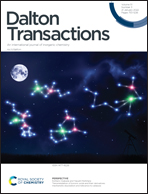Halogen bonding in cadmium(ii) MOFs: its influence on the structure and on the nitroaldol reaction in aqueous medium†‡
Abstract
A solvothermal reaction of Cd(II) with the dicarboxyl-functionalized arylhydrazone pro-ligands, 5-(2-(2,4,6-trioxotetrahydro-pyrimidin-5(2H)-ylidene)hydrazineyl)isophthalic acid (H5L1) and 5-(2-(2,4-dioxopentan-3-ylidene)hydrazineyl)isophthalic acid (H3L2), or their halogen bond donor centre(s) decorated analogs 2,4,6-triiodo-5-(2-(2,4,6-trioxotetrahydropyrimidin-5(2H)-ylidene)hydrazineyl)isophthalic acid (H5L3) and 5-(2-(2,4-dioxopentan-3-ylidene)hydrazineyl)-2,4,6-triiodoisophthalic acid (H3L4), leads to the formation of known [Cd(H3L1)(H2O)2]n (1) and new {[Cd(HL2)(H2O)2(DMF)]·H2O}n (2), [Cd(H3L3)]n (3) and {[Cd2(μ-H2O)2(μ-H2L4)2(H2L4)2]·2H2O}n (4) coordination compounds, respectively. The aggregation of mononuclear units via Cd–O![[double bond, length as m-dash]](https://www.rsc.org/images/entities/char_e001.gif) C and Cd–OH2 coordination and CAr–I⋯I types of intramolecular halogen bonds lead to a dinuclear tecton 4. Both CAr–I⋯O and CAr–I⋯I types of intermolecular halogen bonds play a fundamental role in the supramolecular architectures of the obtained metal–organic frameworks 3 and 4. Theoretical (DFT) calculations confirmed the presence of the CAr–I⋯O and CAr–I⋯I halogen bonds in 3 and 4 and allowed their characterisation. The formation of intermolecular noncovalent interactions between the attached iodine substituents to the hydrazone ligands and polar solvent (water or methanol) molecules promoted, at least in part, the solubility of the corresponding complexes (3 and 4), which act as homogeneous catalyst precursors in the Henry reaction between aldehydes and nitroethane. The corresponding β-nitroalkanol products were obtained in good yields (66–79%) and with good diastereoselectivity (threo/erythro ca. 72 : 28) in water at room temperature.
C and Cd–OH2 coordination and CAr–I⋯I types of intramolecular halogen bonds lead to a dinuclear tecton 4. Both CAr–I⋯O and CAr–I⋯I types of intermolecular halogen bonds play a fundamental role in the supramolecular architectures of the obtained metal–organic frameworks 3 and 4. Theoretical (DFT) calculations confirmed the presence of the CAr–I⋯O and CAr–I⋯I halogen bonds in 3 and 4 and allowed their characterisation. The formation of intermolecular noncovalent interactions between the attached iodine substituents to the hydrazone ligands and polar solvent (water or methanol) molecules promoted, at least in part, the solubility of the corresponding complexes (3 and 4), which act as homogeneous catalyst precursors in the Henry reaction between aldehydes and nitroethane. The corresponding β-nitroalkanol products were obtained in good yields (66–79%) and with good diastereoselectivity (threo/erythro ca. 72 : 28) in water at room temperature.



 Please wait while we load your content...
Please wait while we load your content...